|
Seasons & Weather
We are often asked about the best time to visit the Adirondacks. The answer to that question depends partly upon your own preferences. During the peak seasons there will be more people in the mountains. If you seek solitude, you might better accept less-than ideal conditions and avoid peak season. Rainfall is evenly distributed throughout the year at about 3.3” each month. There is no wet (or dry) season – although we do have a “mud season” that results from melting snow in the spring . Your choice of activity will determine the best time to come and the information below should help you plan your visit. We only accept bookings when there is a good chance the conditions will cooperate with our plans. During the winter we update our Conditions Report every few days.
Seasons Described By Activity
Seasons Described By Month

|
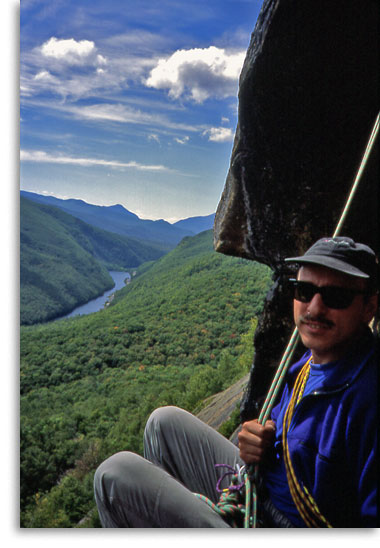 |
|
Belaying on a mid-summer guided first ascent
|
|
|
 |
|
Ready for almost any conditions
|
|
Being Prepared For The Weather
All mountains have their share of difficult weather and the Adirondacks are no exception. Bad weather does not mean you have to abandon all outdoor plans! Experienced alpinists learn to adapt their plans to the weather – or they spend a considerable amount of time feeling cheated by mother nature. In the mountains, climbing or skiing in rain or snow is just another piece of the puzzle – an additional layer of decisions to consider and a new set of skills to master. It requires a conservative approach, and appropriate equipment, but you may find, once you have made some adjustments, it’s actually fun! If you do choose to venture out in difficult conditions keep in mind that no equipment or technique can protect you from electrical storms – avoid them. Also realize that difficult conditions can affect the challenge and risks of your adventure dramatically – so you need to be extremely conservative in what you attempt. At some point, conditions become so difficult that they are intolerable and it makes sense to head for the nearest café. You’ll have to decide when this is for yourself. Just make sure, before you go, that you have a well thought-out plan for getting to shelter and safety if conditions are worse than you thought.
|
|
Seasons Described By Activity: Rock Climbing | Ice Climbing |
Winter Mountaineering | Summer Mountaineering | Backcountry Skiing
|
|
Rock Climbing Season
(late April thru mid-October / Peak: July thru September)
After “mud season” (mid-April, most years) ice and snow will only be present in shady areas and rock climbs start to dry out. By the end of April, most cliffs are in good shape for rock climbing and the season is usually in full-swing. Warming temperatures and lengthening days make this a fine time to climb.
Toward the end of May the infamous black fly starts to hatch and they stick around through June most years. Although black flies can be very irksome for some people, others are hardly bothered. If you climb in areas where they are controlled (biologically or chemically), and stay above the tree-tops, you will likely find them just a minor annoyance. Top-rope at the wrong cliff and you will give blood!
By July, the bugs are mostly gone and the weather is typically ideal for climbing for many weeks – although there may be some hot, muggy, or wet days. As days shorten and nights get cooler the foliage changes, signaling the start of our favorite part of the rock climbing season. From mid-September thru early October the Adirondacks might just be the best place to rock climb on the planet!
Toward the end of October colder temperatures, shorter days and the end of foliage season make rock climbing less attractive. Before, and after, the rock season there are usually a few scattered and unpredictable days of enjoyable climbing. We have climbed warm, dry rock in the Adirondacks during all 12 months of the year, but it has taken almost twenty years to find a warm day in every month! During the winter, rock climbing is reincarnated into mixed climbing – really a variation on ice climbing.
|
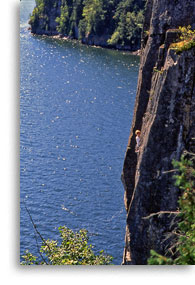 |
|
Cool breezes on a warm day
|
|
|
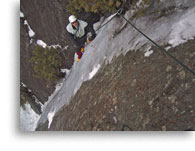 |
|
Early season ice
|
|
Ice Climbing Season
(mid-December thru mid-March / Peak: February thru early March)
Ice usually forms in November but it’s rarely adequate for ice climbing until mid-December. By Christmas there is usually good climbing on the reliable routes, but many will still be too thin to climb. In a good ice year, there will be fat ice on many climbs by mid to late January. Throughout the month of February, and into early March, climbing is usually at its peak. As longer days and warmer temperatures signal the end of winter, there will normally be some delightfully warm days to climb ice – before it melts. In recent years, mixed climbing has become more popular and climbers are finding good sport during the early and late season. Mixed climbing is NOT for novice ice or rock climbers. For a better understanding of ice conditions visit From Water To Ice: How Climbs Form.
|
|
Winter Mountaineering Season
(January thru mid-March / Peak: February thru early March)
Although we normally receive snow earlier, it usually takes until January for the snow pack to accumulate sufficiently for true winter conditions. Late season is often very good due to its well-consolidated snow, longer days and typically warmer winter temperatures. Avalanche hazards can exist at anytime, especially after a large snow, but generally the Adirondacks are not avalanche prone.
Summer Mountaineering & Hiking Season
(late April thru mid-October / Peak: July thru September)
April usually brings warm days, ideal for a mountain hike, but it’s important to wait for the trails to dry out to avoid severely damaging them. Once trails are in good shape, this season is pretty much the same as our Rock Climbing Season (see above).
|
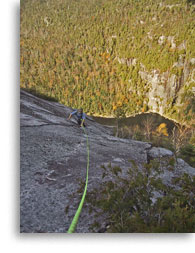 |
|
Late season slide climbing
|
|
|
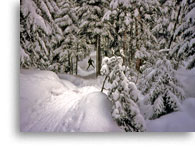 |
|
Fresh powder at peak season
|
|
Backcountry Skiing Season
(mid-January thru March / Peak: February thru early March)
Sometimes the valley trails can be skied prior to Christmas but off-trail skiing usually doesn’t come into condition until mid-January. Because backcountry skiing must rely entirely upon natural snowfall, conditions can vary widely throughout the season and even in different places within a region. A mid-winter rain can leave the backcountry crusted over, making skiing very challenging. Snow storms will bring out local skiers in search of powder but the majority of snow usually falls in small amounts on a frequent basis. In the High Peaks it sometimes snows a couple of inches nearly every day for weeks.
|
|
Seasons Described By Month: January | February | March | April | May |
June | July | August | September | October | November | December
|
|
January (Average Temperatures: HI: 26º F LO: 6ºF)
The year typically begins with some of the coldest temperatures of the winter. Short days make it seem even colder. Ice climbing is just starting to get good, winter mountaineering may be possible and good skiing is usually a couple weeks away. If the cold and snow are persistent, by the end of January all winter activities are near their peak for the season.
February (Average Temperatures: HI: 30º F LO: 8ºF)
This is the best time to plan for winter activities in the Adirondacks. Snow and ice are usually at their peak and days are getting longer. Crowds arrive for the President’s Week school holiday but they are rarely a problem if you know where to go.
March (Average Temperatures: HI: 40º F LO: 17ºF)
Although winter is on its way out, March usually features a few absolutely unbelievable days. Bright sunny skies, perfect temperatures and thick ice or deep snow can make for some fine memories. Unfortunately, one never knows when these days will happen! By the end of March, most of the ice and snow are gone – unless you are willing to hike high into the mountains to ski or climb.
|
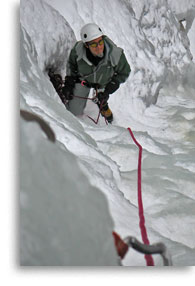 |
|
Fully formed mid-season ice
|
|
|
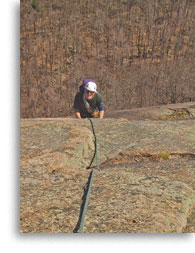 |
|
First rock climb of the season
|
|
April (Average Temperatures: HI: 53º F LO: 30ºF)
This is a transitional month. There is usually some good skiing at higher elevations at the beginning of the month and by the end of April rock climbing season is usually in full swing. This is also when our infamous “mud season” makes the mountains the last place you want to be! Most locals leave the area on vacation during April (hint, hint).
May (Average Temperatures: HI: 66º F LO: 38ºF)
The area receives relatively few visitors in May, but this is usually a very pleasant time to climb or hike in the Adirondacks. Memorial Day, at the end of the month, marks the start of the busy season and it’s usually also marked by the arrival of black flies.
June (Average Temperatures: HI: 73º F LO: 48ºF)
Early June is usually the peak of black fly season but the weather is typically fine and there will be few crowds.
|
|
July (Average Temperatures: HI: 77º F LO: 53ºF)
This is peak season for all summer activities in the Adirondacks. You can expect nearly ideal conditions except for the occasional thunderstorm.
August (Average Temperatures: HI: 74º F LO: 49ºF)
Just like July.
September (Average Temperatures: HI: 67º F LO: 41ºF)
After Labor Day the mountains are almost totally empty for a couple of weeks and climbing/hiking conditions are at their best. In mid/late September foliage season brings hoards of weekend “leaf-peepers” but mid-week is usually very quiet.
|
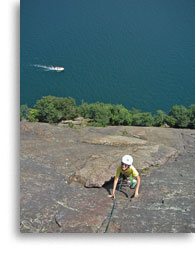 |
|
Kevin Stolz, beating mid-summer heat
|
|
|
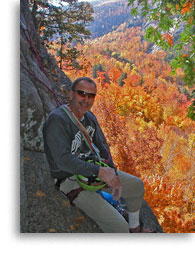 |
|
Tail-end of foliage season
|
|
October (Average Temperatures: HI: 54º F LO: 37ºF)
This month usually starts out warm and beautiful, ideal for climbing. By the end of October days are getting quite short and cold temperatures are common.
November (Average Temperatures: HI: 42º F LO: 22ºF)
We rarely guide in the Adirondacks during November. Cold temperatures combined with very short days and insufficient ice to climb make it a month to travel for many Adirondack locals.
December (Average Temperatures: HI: 30º F LO: 8ºF)
Marginal ice climbing is sometimes possible at the start of December and it’s often quite good by the end of the month. Skiing may be possible on some trails but it’s rarely good off-trail until January.
|
|
|
|
|











